Massive M7.6 earthquake hits near the west coast of Honshu, Japan — major tsunami warning issued for Ishikawa
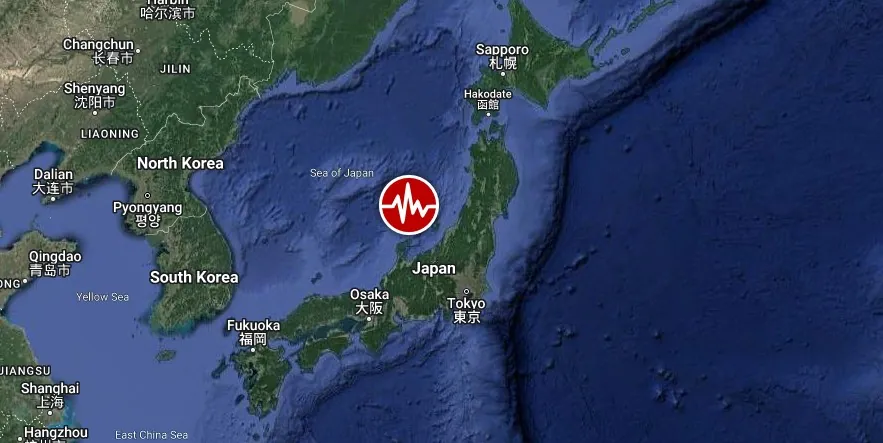
A very strong and shallow earthquake registered by the JMA as M7.6 (preliminary) hit near the west coast of Honshu, Japan at 07:10 UTC (16:10 local time) on January 1, 2024. USGS and EMSC are reporting it as M7.5 at a depth of 10 km (6.2 miles).
- A major tsunami warning has been issued for Ishikawa Prefecture. Tsunami warnings were also issued for Niigata, Toyama, Yamagata, Fukui and Hyogo prefectures along the Japan Sea coast.
- Residents in the coastal Noto area in Ishikawa Prefecture were asked to evacuate immediately to higher ground.
- Authorities have warned of waves as high as 5 m (16.4 feet) in Noto.
- Russia also issued tsunami warnings in its far eastern cities of Vladivostok and Nakhodka.
The epicenter was located in Ishikawa Prefecture, Noto Peninsula about 42.1 km (26.2 miles) NE of Anamizu (population 17 840), 55.4 km (34.4 miles) NNE of Nanao (population 45 309), 66.4 km (41.2 miles) NNW of Nyūzen (population 25 007), 68.8 km (42.8 miles) NNW of Kurobe-shi (population 41 564), and 88.7 km (55.1 miles) N of Toyama (population 415 844).
17 000 people are estimated to have felt violent shaking, 144 000 severe, 577 000 very strong, and 3 337 000 strong.
A tsunami around 1 m (3.3 feet) high struck parts of the west coast along the Sea of Japan, with a larger wave of up to 5 m (16.4 feet) expected, public broadcaster NHK reported.
This is the first time a “major tsunami warning” was issued since the 2011 earthquake in northeastern Japan. The warning is issued when tsunami of 3 m (10 feet) or more are expected.
First visuals of HUGE wave hitting Suzu City in Japan#Earthquake #Japan #tsunami pic.twitter.com/aPMY6in36g
— @Rajesh Beniwal_123 ✍✍ ❤️ 🚜 (@RajeshB00811029) January 1, 2024
Officials of Ishikawa Prefecture's Suzu City say they have confirmed several houses and power poles have collapsed following a magnitude 7.4 quake Monday afternoon. https://t.co/IhqLpATlRE
— NHK WORLD News (@NHKWORLD_News) January 1, 2024
An official at the Japan Meteorological Agency said people in coastal areas and along rivers where tsunami warnings have been issued should immediately evacuate to safe places.
— NHK WORLD News (@NHKWORLD_News) January 1, 2024
For more on this, visit: https://t.co/qoF8j5GhZV
Tsunami waves have been observed following the quake, NWS PTWC said at 08:57 UTC. Based on all available data, hazardous tsunami waves are forecast for some coasts. Tsunami waves reaching 0.3 to 1 m (1 – 3 feet) above the tide level are possible for some coasts of DPR of Korea, Japan, and Russia. Tsunami waves are forecast to be less than 0.3 m (1 foot) above the tide level for the coasts of the Republic of Korea.
Footage aired by NHK showed buildings collapsing in Ishikawa, and tremors shook buildings in the capital Tokyo on the opposite coast, local media reported.
More than 36 000 households lost power in Ishikawa and Toyama prefectures, utilities provider Hokuriku Electric Power said.
Japan’s Nuclear Regulation Authority said no irregularities have been confirmed at nuclear power plants along the Sea of Japan, including five active reactors at Kansai Electric Power’s Ohi and Takahama plants in Fukui Prefecture. Hokuriku’s Shika plant in Ishikawa, which was located the closest to the quake’s epicenter, had already halted its two reactors before the quake for regular inspection and saw no impact from the quake, the agency said.
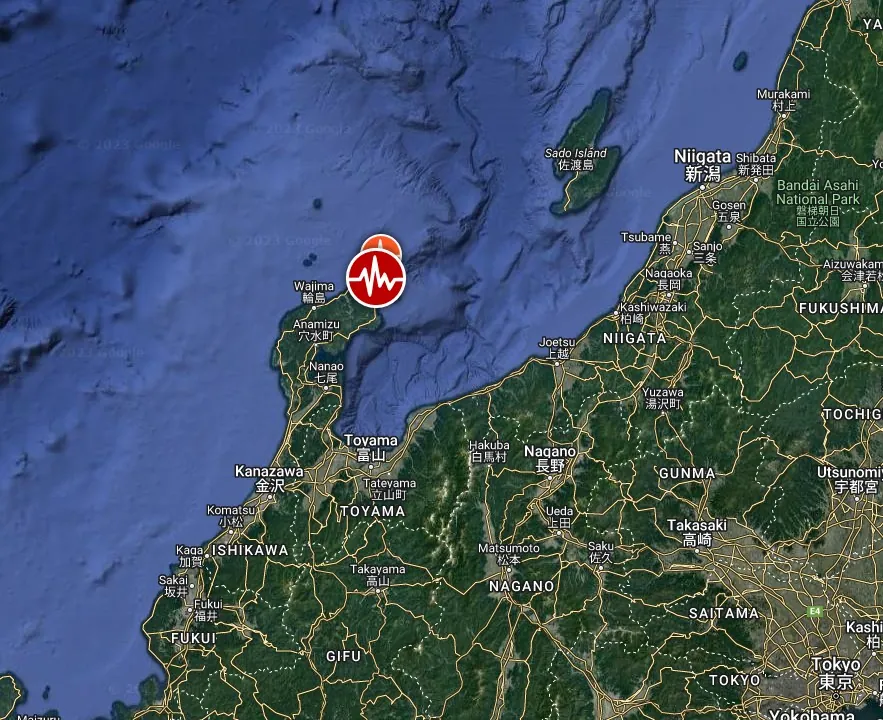

Extensive damage is probable and the disaster is likely widespread. Estimated economic losses are less than 1% of GDP of Japan. Past events with this alert level have required a national or international level response.
Overall, the population in this region resides in structures that are resistant to earthquake shaking, though vulnerable structures exist. The predominant vulnerable building types are heavy wood frame and reinforced/confined masonry construction.
Recent earthquakes in this area have caused secondary hazards such as tsunamis, landslides, fires and liquefaction that might have contributed to losses.
Estimated population exposure to earthquake shaking
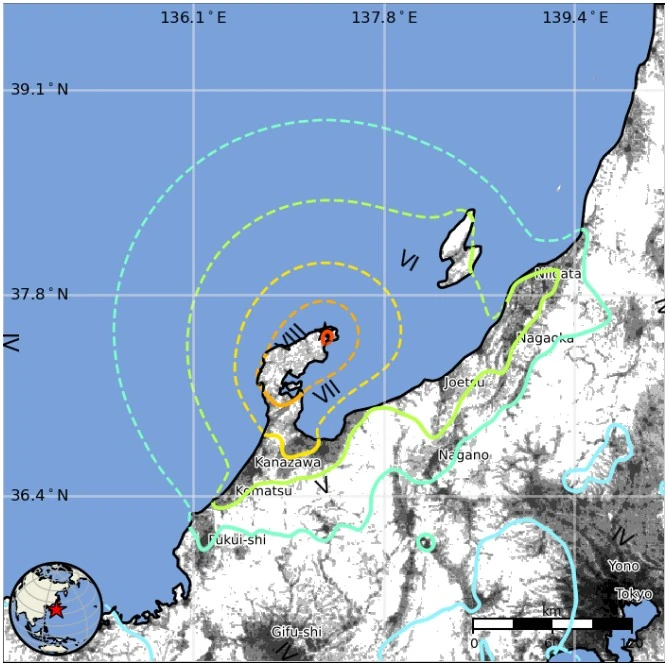

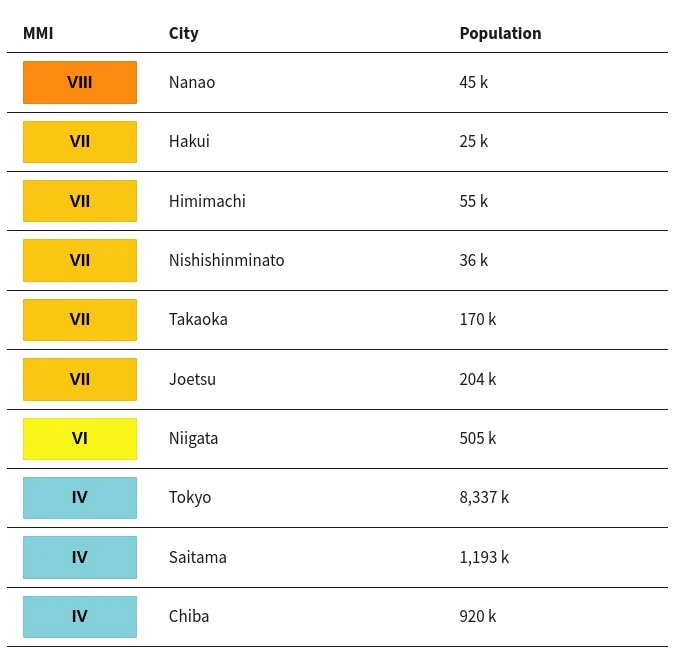

Selected cities exposed
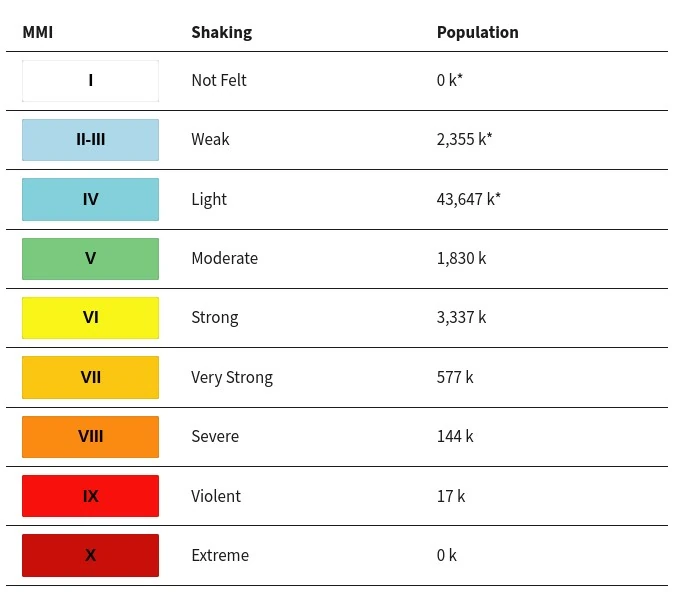

Regional seismicity
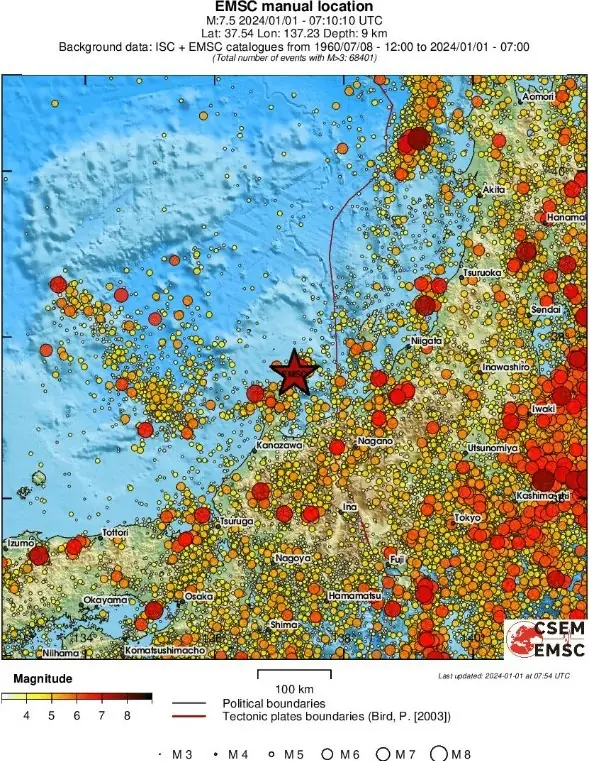

Update
10:02 UTC, January 1, 2024
Numerous aftershocks have been reported, including M6.1 at 07:18.
The following are tsunami wave observations from coastal and/or deep-ocean sea level gauges at the indicated locations, as reported by NWS PTWC at 09:49 UTC. The maximum height is measured with respect to the normal tide level.
| GAUGE LOCATION | COORDINATES | TIME OF MEASURE (UTC) | MAXIMUM TSUNAMI HEIGHT | WAVE PERIOD (MIN) |
|---|---|---|---|---|
| FUKAURA JP | 40.6N 139.9E | 0859 | 0.37M/ 1.2FT | 08 |
| SAIGO JP | 36.2N 133.3E | 0847 | 0.22M/ 0.7FT | 04 |
| SADO JP | 38.3N 138.5E | 0842 | 0.31M/ 1.0FT | 08 |
| TOYAMA JP | 36.8N 137.2E | 0727 | 0.58M/ 1.9FT | 14 |
The Japan Meteorological Agency (JMA) also reported maximum crest to mean wave heights from the following stations:
| LOCATION | TIME (UTC) | MAXIMUM WAVE HEIGHT (cm) | MAXIMUM WAVE HEIGHT (feet) |
|---|---|---|---|
| WAJIMAKO | 0721 | Over 120 cm | 3.94+ feet |
| TOBISHIMA | 0852 | 40 cm | 1.31 feet |
| SAKATA | 0822 | 30 cm | 0.98 feet |
| NIIGATA | 0809 | 30 cm | 0.98 feet |
| KASHIWAZAKISHI KUJIRANAMI | 0736 | 40 cm | 1.31 feet |
| KANAZAWA | 0846 | 50 cm | 1.64 feet |
| TOYOOKASHI TSUIYAMA | 0852 | 30 cm | 0.98 feet |
| OKUSHIRITO OKUSHIRIKO | 0828 | 10 cm | 0.33 feet |
| AKITA | 0836 | 10 cm | 0.33 feet |
| MAIZURU | 0849 | 10 cm | 0.33 feet |
| IWAMICHO TAJIRI | 0846 | 10 cm | 0.33 feet |
| SAIGO | 0850 | 30 cm | 0.98 feet |
10:34 UTC
The city of Toyama, Toyama prefecture, reported a tsunami of 80 cm (2.6 feet) at 07:35 UTC (16:35 LT).
The tsunamis are expected to repeatedly hit the coast and may become higher. People in those areas must evacuate immediately and escape to higher ground to stay far away as possible from the coast, NHK reported.
10:41 UTC
Reports are emerging of widespread damage, including a significant fire in Wajima City, medical responses in Suzu City with some doctors unable to access the hospital, and infrastructure damage in Himi and Oyabe, Toyama Prefecture, with reports of road cracks and broken water pipes. The affected hospital is relying on a spare generator due to power outages.
The East Japan Railway Company has suspended the Akita Shinkansen line and partially halted Hokuriku Shinkansen services post-quake, with resumption times unclear. Meanwhile, the Nuclear Regulation Authority reports no issues with the Shika nuclear plant’s reactors in Ishikawa Prefecture, which, as noted by Hokuriku Electric, were offline prior to the earthquake.
11:44 UTC
JMA has downgraded the “major tsunami warning” issued for Ishikawa Prefecture. A “tsunami warning” is now in effect for the prefecture and other prefectures around the region, and officials are urging caution.
People in those areas are being asked to evacuate immediately, escape to higher ground and get as far away as possible from the coast.
The agency says tsunamis will repeatedly hit the coast and may become higher.
11:49 UTC
Chief Cabinet Secretary Hayashi Yoshimasa confirmed many buildings collapsed following the quake in Ishikawa Prefecture. At a news conference, he noted ongoing damage assessments and reported six instances of individuals trapped. He urged the public to heed emergency information and evacuate if in tsunami warning areas.
17:40 UTC
JMA has downgraded all tsunami warnings along the Sea of Japan to advisories.
Authorities are urging residents to remain on the alert, as earthquakes of similar intensity will remain a possibility for about a week, and especially in the next two to three days.
More than 80 aftershocks have been recorded by the JMA.
Reports of damage continue to come in.
17:58 UTC
Fire officials in Ishikawa report collapsed houses and trapped residents post-quake. Prime Minister Kishida Fumio is leading relief efforts, with challenges in deploying forces due to damaged roads. He’s ordered essential supplies delivered amid severe cold forecasts, with injuries reported across multiple prefectures. Two individuals in Nanao City suffered cardiac arrest.
22:30 UTC
As of early Tuesday (local time), Ishikawa officials report four deaths, including an elderly man from a collapsed house. Wajima experienced a significant fire affecting over 50 structures. The fire department is handling numerous reports of collapsed buildings and people trapped in damaged buildings. Injuries span across four prefectures, including Niigata and Toyama.
22:43 UTC
Japan is a seismically active region, with most earthquakes occurring off the east coast, where the Pacific plate subducts beneath Japan, USGS noted.
This earthquake occurred on the west coast of Japan where crustal deformation created by the broader plate motions is accommodated in shallow faults. Shallow earthquakes cause more damage than intermediate- and deep-focus ones since the energy generated by the shallow events is released closer to the surface and therefore produces stronger shaking relative to earthquakes located deeper within the Earth. This coastal earthquake produced both strong shaking on land and generated a tsunami.
While earthquakes are common in Japan, the region surrounding the January 1, 2024, earthquake sees lower rates of seismicity as compared to the major subduction zone along its east coast. Still, since 1900, 30 other M6 and larger earthquakes have occurred within 250 km (155 miles) of the January 1 event.
Three of these occurred on or near the Noto Peninsula, where the January 1 event is located. On May 5, 2023, a M6.2 earthquake on the Noto Peninsula killed one person and damaged hundreds of buildings. On June 16, 1964, a M7.6 occurred 205 km (127 miles) east-northeast of the January 1 event, resulting in 36 fatalities and roughly 3 500 destroyed homes.
07:31 UTC, January 2
At least 30 people are confirmed dead in Ishikawa Prefecture, with potential for more as rescues continue. Tsunami advisories have been lifted, but aftershock warnings persist. Prime Minister Kishida emphasizes relief challenges and potential use of ships for aid delivery. In Wajima City, 25 buildings have collapsed, and people could still be trapped in 14 of them.
07:35 UTC
The quake caused significant land shifts in Ishikawa Prefecture’s Noto region, with the largest being about 1.3 meters (4.3 feet) westward in Wajima City. Other areas like Anamizu Town and Suzu City saw shifts of 1 meter (3.28 feet) and 80 cm (2.62 feet), respectively. Toyama and Niigata experienced shifts of around 20 cm (7.87 inches), and smaller shifts occurred in the Kanto-Koshin region.
10:50 UTC
The death toll reached 48.
A 3 000-strong rescue team, including army personnel, firefighters, and police, has been deployed to the earthquake-affected Noto peninsula.
Prime Minister Kishida emphasizes the urgency of rescue efforts amid challenges in reaching the hardest-hit areas, where aerial surveys reveal extensive fires and damage. Around 120 people are awaiting rescue.
11:35 UTC, January 3
The death toll has reached 73 and dozens more are believed to be trapped under collapsed buildings.
“More than 40 hours have passed. This is a race against time, and I feel that we are at a critical moment,” Prime Minister Fumio Kishida told reporters. “We have received reports many people are still waiting for rescue under collapsed buildings.”
15:24 UTC, January 4
The confirmed death toll of 84 makes it Japan’s deadliest quake since 2016. 179 people are still unaccounted for. On April 16, 2016, a M7.3 struck Kumamoto, killing more than 220 people.
The cities of Wajima and Suzu accounted for the majority of the confirmed total.
As of January 4, 48 deaths had been reported in Wajima, and 23 in Suzu. A total of 305 people are injured.
17:10 UTC, January 5
The death toll has further increased to 94 and the number of missing people to more than 200.
Several roads remain cut off, making it difficult to reach survivors, NHK reports.
About 32 000 people are in evacuation centers in the prefecture. The local government says about 66 000 households are still without water.
13:36 UTC, January 6
The death toll has reached 126 and the number of people still unaccounted for is above 200.
At least 10 people are believed to be trapped in part of the town of Anamizu.
Several roads still remain blocked, making it difficult to reach survivors.
08:56 UTC, January 8
The death toll has risen to 161. In addition, 103 people aged between 8 and 95 are still missing.
An estimated 10 000 people in Ishikawa Prefecture are still in evacuation centers.
Over 2 000 people in the prefecture remain isolated due to damaged roads.
Heavy snowfall and sub-zero temperatures are hindering rescue efforts, prompting the government to plan food deliveries on foot in severely affected areas.
A week after the tragedy, a water shortage has exacerbated hygiene and sanitary conditions in the region.
09:49 UTC, January 9
The death toll has risen to 202 and there are still more than 100 people unaccounted for, according to Ishikawa Prefecture officials.
Police in Wajima have launched an intensive search for missing persons.
A major fire in Wajima’s city center destroyed over 200 buildings, covering an area of 48 000 m2 (516 000 ft2).
In the Noto region of Ishikawa Prefecture, more than 3 000 people remain isolated, NHK reports.
Evacuee and volunteer Yamashita Kanako at a Wajima City shelter reports a shortage of drinking water, with residents boiling spring water and fetching river water to flush toilets. Road damage has prompted relief organizers to employ drones for delivering medicine to those cut off in Wajima City’s Konosu district, with plans to continue drone support for those in need.
The earthquake’s impact on Ishikawa’s fishing industry is severe. More than 120 fishing boats were capsized or sunk, and over 70% of the ports sustained damage, indicating a lasting effect on the region’s vital industry.
11:21 UTC, January 15
As of 05:00 UTC, the death toll in Ishikawa Prefecture has risen to 222, as reported by the prefectural government.
This figure includes 14 disaster-related deaths caused by health deterioration during evacuation. The fatalities are distributed across various municipalities: 99 in Suzu, 88 in Wajima, 20 in Anamizu, 7 in Noto, 5 in Nanao, 2 in Shika, and 1 in Hakui. Additionally, 22 people remain unaccounted for, with 18 in Wajima and 4 in Suzu.
Featured image credit: TW/SAM, Google


Commenting rules and guidelines
We value the thoughts and opinions of our readers and welcome healthy discussions on our website. In order to maintain a respectful and positive community, we ask that all commenters follow these rules.